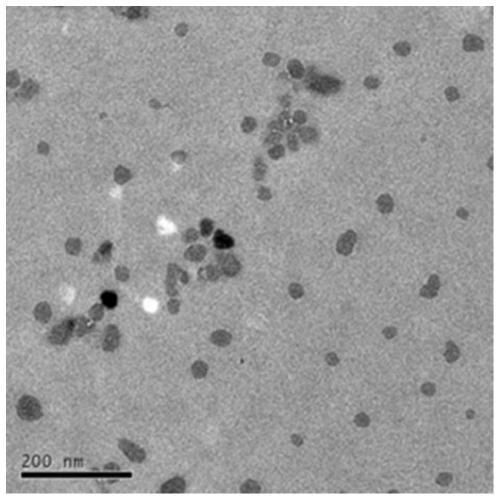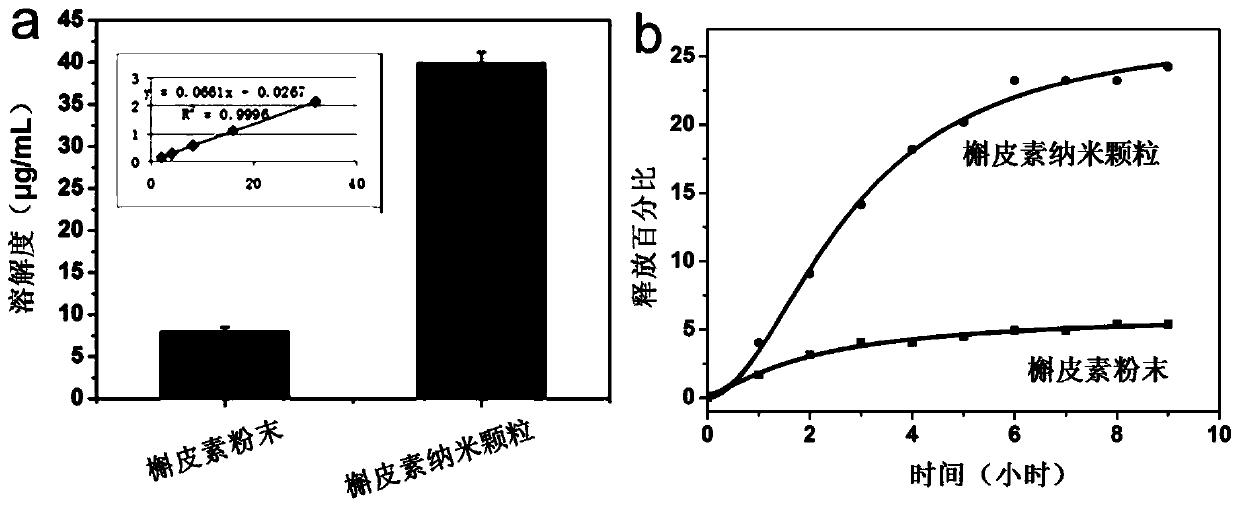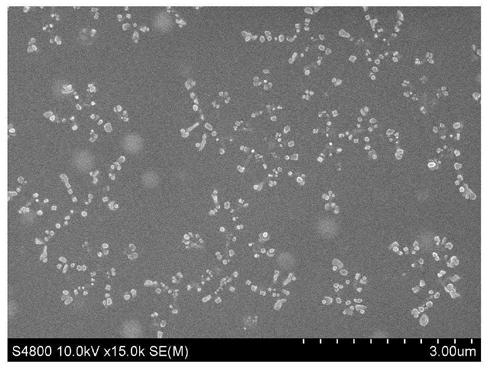A kind of nanoparticle of insoluble drug and its preparation method and application
A technology of insoluble drugs and nanoparticles, applied in application, nanotechnology, pharmaceutical formulations, etc., can solve problems such as poor solubility and low bioavailability, and achieve the effects of improved solubility, good application prospects, and nano-drug purity.
- Summary
- Abstract
- Description
- Claims
- Application Information
AI Technical Summary
Problems solved by technology
Method used
Image
Examples
Embodiment 1
[0024] This example provides a kind of insoluble drug nanoparticles. The specific preparation method is: weigh 500mg of quercetin and 10mg of polyvinylpyrrolidone, mix them thoroughly in a mortar, and compress them on an infrared tablet machine. The target is placed in 10 mL of pure water, a laser with an energy of 30 mJ is focused on the sheet-shaped target, and ablated for 30 min under magnetic stirring at a rotational speed of 1000 rpm to obtain the final product.
[0025] figure 1 The TEM image of the quercetin nano drug particles prepared in this example. figure 1 The particle size of the quercetin nano-medicine particles in the drug is 50-100nm, uniform in size and good in dispersibility.
[0026] A. The solubility of the obtained nanoparticles was detected according to the following method: different concentrations of quercetin powder (2, 4, 8, 16, 32 μg / mL) were dissolved in DMSO, and a standard curve was obtained by UV quantification. The quercetin powder and the na...
Embodiment 2
[0032] This example provides a poorly soluble drug nanoparticle. Compared with Example 1, the only difference is that the dosage of polyvinylpyrrolidone is 25 mg, and the ablation time is 10 minutes.
[0033] image 3 SEM image of the nanoparticles prepared in this example. It can be seen from the figure that the uniformity of particle size and shape is better, but due to the coating of a large number of polymer materials, the yield of nano drug particles is significantly reduced.
[0034] According to the same method as in Example 1, the solubility and dissolution rate of the product obtained in this example were evaluated. As can be seen from the results, drug solubility and dissolution rate have no significant change compared with Example 1.
Embodiment 3
[0036] This example provides a poorly soluble drug nanoparticle. Compared with Example 1, the difference is only that: the amount of polyvinylpyrrolidone is 5 mg; and the laser power is 50 mJ, and the ablation time is 20 min.
[0037] Figure 4 SEM image of the nanoparticles prepared in this example. It can be seen from the figure that due to the high energy of laser ablation, when the polymer material is 5 mg, the large amount of nano drug particles cannot be effectively coated, resulting in the formation of rod-shaped drug particles.
[0038] According to the same method as in Example 1, the solubility and dissolution rate of the product obtained in this example were evaluated. As can be seen from the results, the solubility and dissolution rate of the product of this embodiment are slightly worse than those of Example 1.
PUM
| Property | Measurement | Unit |
|---|---|---|
| particle diameter | aaaaa | aaaaa |
Abstract
Description
Claims
Application Information
 Login to View More
Login to View More - R&D
- Intellectual Property
- Life Sciences
- Materials
- Tech Scout
- Unparalleled Data Quality
- Higher Quality Content
- 60% Fewer Hallucinations
Browse by: Latest US Patents, China's latest patents, Technical Efficacy Thesaurus, Application Domain, Technology Topic, Popular Technical Reports.
© 2025 PatSnap. All rights reserved.Legal|Privacy policy|Modern Slavery Act Transparency Statement|Sitemap|About US| Contact US: help@patsnap.com



